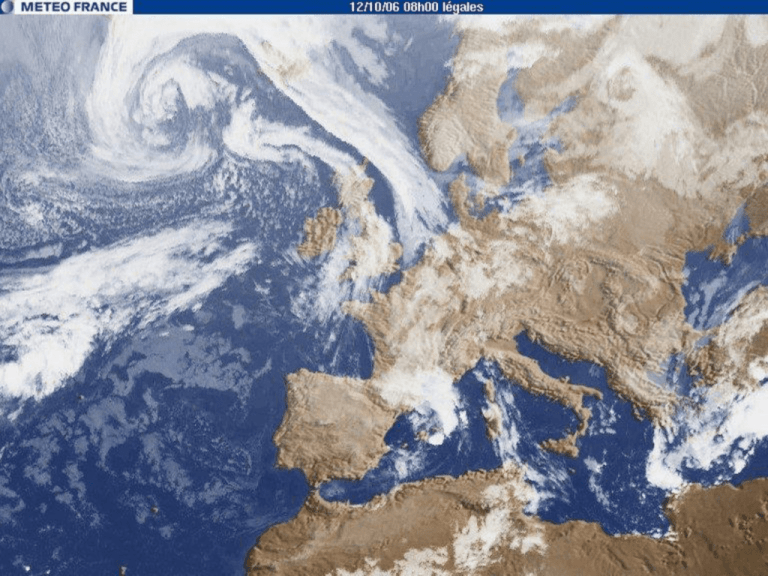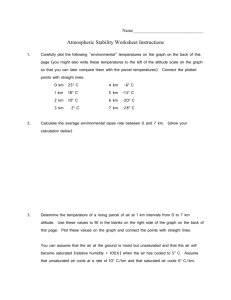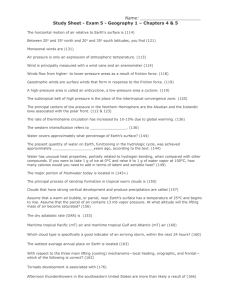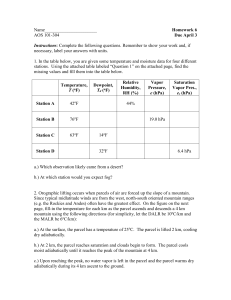Lecture 4, Atmospheric stability, Thu. Oct. 12 2006.
advertisement

Atmospheric Stability and Cloud Formation Recall: Saturation is when evaporation = condensation Also remember that the higher the air temperature, the more water vapor will be present in the air at saturation. Relative humidity = actual water vapor in air/maximum water vapor possible Relative humidity depends on two factors: the actual amount of moisture in the atmosphere the temperature remember that temperature determines how much water vapor can be in the air at saturation We can express/calculate Relative Humidity in a variety of ways: RH=[(vapor pressure)/(saturation vapor pressure)] X 100% RH=[(mixing ratio)/(saturation mixing ratio)] X 100% Dew Point = the temperature to which air must be cooled in order to become saturated Dewpoint temperature is a better "absolute" measure of moisture in the air. Why? Because it doesn't change when the air temperature changes; it only changes when the moisture content changes. (Assuming constant pressure). For example: Temperature Dew Point Relative Humidity 30 10 29% 20 10 53% 10 10 100% High dew points mean high moisture content of the air, which often translates to muggy and uncomfortable conditions. In general, most people consider dew points above 20 degrees C very uncomfortable (regardless of air temperature and relative humidity). NOTE: Dew point temperature can NEVER be greater than the actual air temperature When air temperature = dew point temperature, RH = 100% One of the clues a meteorologist uses for forecasting tonight's low temperature is to look at today's dew point: if no fronts are expected to come through, tonight's low temperature will not get much below today's dew point. WHY? Quick summary of conditions of saturation • • • • Air temp = dewpoint temp Relative humidity = 100% Mixing ratio = saturation mixing ratio Vapor pressure = saturation vapor pressure Once saturation is reached: 1) If more water is added, then condensation will dominate 2) If temperature is decreased, then condensation will dominate In other words, a cloud will form (given presence of CCN, etc.) To make a cloud we need really only 3 things: • Moisture • Cloud Condensation Nuclei (CCN) or Ice Nuclei (IN) (more detail later on this) • A method of cooling the air to saturation So how, exactly, do convective clouds form in the atmosphere? Pressure is essentially the “weight” of the atmosphere above you As you go up, less atmosphere is above you, so pressure is less This is why your ears “pop” as you drive up a mountain or go up in an airplane -- basically air inside your ears has retained the pressure of the lower elevation and starts to expand Consider a “parcel” of air at 1000 millibars (that is, at the ground) Assume that the parcel is not saturated The parcel will exert 1000 mb of pressure to counteract the atmospheric pressure acting on the parcel. i.e., parcel pressure is in equilibrium If we take this parcel of air at Earth’s surface and somehow lift it up to 500 mb: • as we go higher in the atmosphere, there is less atmosphere above us • with fewer molecules pressing on our parcel of air, the molecules in the parcel can move more and the parcel can expand • when a parcel expands, the molecules are “doing work” ΔU = Q – W • when molecules do work, they lose energy so the parcel cools That is – RISING AIR ALWAYS COOLS Short aside: first law of thermodynamics ΔU = Q – W Change in internal energy Heat added to the system Work done by the system When air parcels rise (or sink), the process is labeled adiabatic. Physically, this simply means the parcel keeps its heat constant (remember, heat and temperature are not the same!!) (Q in the equation above does not change) Recall: temperature is a measure of kinetic energy. As kinetic energy increases, temp will increase. As kinetic energy decreases, temp decreases. So – we know that rising/sinking parcels are “doing work” – thus we know they are change their internal energy. Parcel Temperature Internal energy Work Rises cools decreases done by Sinks warms increases done to Short derivation based on the first law of thermodynamics (derivation posted on course web page). PARCEL lapse rates Don’t confuse “parcel” lapse rates with “environmental lapse rates” – the two are different! Rising air parcels will COOL. IF UNSATURATED, their rate of cooling is fixed: 10°C / km (ten degrees celsius per kilometer). A parcel that rises 500 m (1/2 km) will cool 5C, one that rises 1267 m will cool 12.67C. The math is simple This lapse rate is called the “dry adiabatic lapse rate”. Sinking parcels are – by definition – unsaturated. WHY? Their rate of warming is fixed at the dry adiabatic lapse rate. I.e., sinking parcels always warm at 10°C / km What happens when the rising parcel becomes saturated? As an air parcel rises and cools, the relative humidity increases When the parcel cools to the point when the parcel temperature and the dew point temperature are equal, RH will be 100% If lifting continues, the parcel will continue to cool – BUT the parcel would be “supersaturated” (not good) Thus, it MUST “expel” water vapor – & condensation occurs The difference between wet adiabatic lapse rate (6 C / km) and dry adiabatic lapse rate (10 C / km) is due to latent heat release Notice also that MOST rising parcels first cool at the dry rate, then reach saturation & cool at the wet rate. • Short temperature calculation exercise Parcel air temp & dewpoint temp example Cloud Formation When we lift the air, where will condensation occur? Depends on the moisture content of the air that is being lifted. The lifting condensation level (LCL) is the altitude (usually expressed as a pressure) at which the lifted air is cooled dry adiabatically to saturation. Clouds will form at this level. Typo: 6C/km Now all we have to do is get the parcel of air lifted. We can do that in four ways: Orographic Lifting Frontal Uplift (also known as frontal wedging) Convergence Convection Orographic Lifting Air is forced upward by topography As air is forced up the mountains (windward side) it cools, forms clouds, and maybe precipitation As air goes down the mountain on the leeward side, it is compressed and warms Therefore it is usually wetter on the windward side than on the leeward side. Atmospheric stability Why do some clouds stay relatively thin while others may grow to the depth of the troposphere? -- It has to do with how STABLE the atmosphere is at a given time and place Why do clouds almost never grow up into the stratosphere? Basic definition of stability: When air parcels are warmer than their environment, they are unstable (and will seek to rise) When air parcels are cooler than their environment, they are stable (and seek to sink) How do we find out what the temperature of the “environment” is? Weather balloons are the primary source of data above the ground. They provide valuable input for computer forecast models, local data for meteorologists to make forecasts and predict storms, and data for research. Twice a day, every day of the year, weather balloons are released simultaneously from almost 900 locations worldwide, including 92 released by the National Weather Service in the US and its territories. The balloon flights last for around 2 hours, can drift as far as 125 miles away, and rise up to over 100,000 ft. (about 20 miles) in the atmosphere. These balloon-borne instruments are sent aloft just prior to 0000 UTC and 1200 UTC on each day. During their ascent, they radio back to the ground-based receiving station a nearly continuous stream of information until the balloon bursts at approximately 10 mb. Now that we have data from the atmosphere, what do we do with it? The data that are collected from radiosonde instruments are called soundings. Also, when these data are plotted on special charts called thermodynamic diagrams, these plots are called soundings. Lower pressures correspond to higher altitudes. So most thermodynamic diagrams (thermo diagrams, for short) have pressure plotted along the vertical axis (decreasing upward on the graph), and temperature plotted along the horizontal axis. Thus, the top of the graph corresponds to higher altitudes, and the right side corresponds to warmer temperatures. On this blank graph, we can plot the sounding measurements such as a temperature and dew point for a variety of heights. We get a sense of how saturated the environment is at certain pressure levels. Dots are temperature (T), and x's are dew-point temperature (Td) An actual sounding has much more information on it than just temperature and dew point Most important use of a sounding: -- show (graphically plot) how atmospheric variables CHANGE WITH HEIGHT Air temperature (red) Dewpoint temperature (green) Wind speed & direction (black “flags” & “barbs”) Pressure (blue), & by analogy, height Stability summary • 3 types of environmental stability: – Absolutely stable – Absolutely unstable (very uncommon) • Does occur in few tens of feet above parking lots & roads in summer (mirages are often co-located) – Conditionally unstable • Conditional on when the rising air parcel reaches saturation (i.e., the height of the LCL) – If parcel can maintain its temperature WARMER than environment, then it remains unstable








